Happy National Week of Making! At Techbridge, Making is a big part of the afterschool and summer STEM programming we deliver to girls in underserved communities in the San Francisco Bay area, Seattle, and Washington, DC. We just finished our Bay area Summer Academy, a weeklong Making experience where middle-school girls designed and built robot animals, made their own spin art machines, and did other activities that connected engineering, science, and art.
Making can provide an authentic context for learning that creates high levels of engagement, develops creativity and persistence, and exposes girls to real-world science and engineering practices. But what does high-quality, equitable Making look like in action? And what are some steps that facilitators can take to ensure that all youth are engaged and learning?
Here are some best practices developed through Techbridge’s experiences with youth Making:
Take Time to Build a Community of Makers
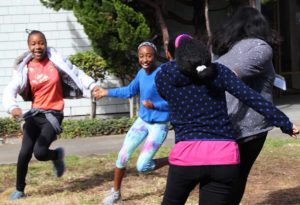 Whether youth will be together for a week or a year, it’s important to build trust and create a community where youth are comfortable working together, learning from one another, and taking risks.
Whether youth will be together for a week or a year, it’s important to build trust and create a community where youth are comfortable working together, learning from one another, and taking risks.
An important part of our programs is culture building. At the beginning of Summer Academy, Techbridge program coordinators facilitated a group norm-setting session where girls decided together what they wanted their community to look like. Every day, there were icebreakers and get-to-know-you activities. We also do icebreakers at the beginning of each afterschool program.
Although these activities take time, they help to create a supportive space where it’s OK try new things, ask for help when you need it, and dream big.
Encourage Youth Choice
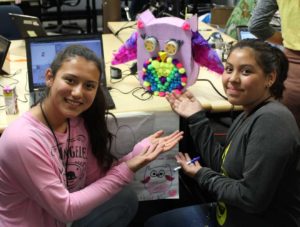
Making activities run the gamut, from step-by-step directions that produce a specific end result to completely open-ended building. There’s certainly a time and place for step-by-step activities, which can scaffold learning for new Makers. However, most of our projects give youth meaningful choices about the direction they will take their own work.
In our high school programs, this means that girls spend much of the year building projects of their own design to take to the local Maker Faire; in our middle and elementary programs, we often start with a prompt, concept, or design challenge (e.g. “make a robot that can interact with humans”) that gives girls focus and the room to make projects their own.
Why? Youth are more invested in projects when they have ownership. Seeing their own ideas come to life is a strong motivator for gaining knowledge and skills, from soldering to working with photoresistors. Youth choice also fosters equity, giving youth the opportunity to bring their expertise, background, and personal interests to the project and community.
Build Peer and Near-Peer Leadership
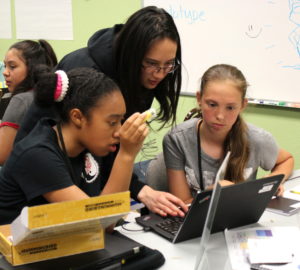 Taking on the role of an expert can be an empowering experience for youth. One way to develop peer leadership within a program is to be intentional about identifying participants with more experience or expertise and actively encourage them to support their peers and share knowledge.
Taking on the role of an expert can be an empowering experience for youth. One way to develop peer leadership within a program is to be intentional about identifying participants with more experience or expertise and actively encourage them to support their peers and share knowledge.
In a near-peer model, programs can bring in college students as role models or mentors, or bring high schoolers into programs for younger grades. During Summer Academy, we invited girls from Techbridge’s high school programs to act as group leaders for middle school participants. This approach gave older girls an opportunity to develop leadership skills, gave younger girls role models and extra support, and gave program coordinators assistance in facilitating complex projects.
Acknowledge Challenges and Focus on Process, Not Product
Making activities can be challenging, and ambitious projects may not always turn out the way we intended. Acknowledge that youth may face setbacks along the way. We take time during programs to share our “Glorious Goofs.” Challenges can also be framed as a crucial part of the design iteration process and as learning opportunities that can lead to growth and new ideas. (For more information about addressing and reframing failure, see this blog post and this paper.)
Our facilitators also encourage girls to think about the skills they are gaining, and the ideas they are developing, as the most important things they’ll take away from the project. We often talk about girls’ work as prototyping, rather than setting an expectation of creating polished products.
Share Models and Your Own Making Experiences

At the beginning of a new project, we often share samples made by facilitators or girls in other programs. Youth love to see and play with physical examples, which can spark ideas for those who may be struggling to get started. (If you can, make a variety of models; we’ve found that if there’s just one kind, youth may be tempted to copy it.) Making models ahead of time also gives facilitators direct experience with the project and can help them see potential challenges youth might face and develop troubleshooting strategies.
When you show models to youth, you can also share the design and building process that you went through. It can be particularly helpful to share some struggles that you experienced. It’s OK if your projects aren’t finished or don’t work! It’s important for youth to see work in progress and “failures”, too.
Don’t Forget About Aesthetics
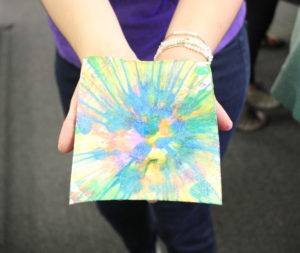 Although Making encompasses a wonderful variety of interests and skills, it often seems like the spotlight is turned on projects that are tech-heavy and focus on function over form. These projects don’t always appeal to the girls that we work with. We’ve found that for some youth, the way a project looks is just as important as what it does, and we are learning to build in time for visual design, alongside the coding and engineering.
Although Making encompasses a wonderful variety of interests and skills, it often seems like the spotlight is turned on projects that are tech-heavy and focus on function over form. These projects don’t always appeal to the girls that we work with. We’ve found that for some youth, the way a project looks is just as important as what it does, and we are learning to build in time for visual design, alongside the coding and engineering.
Although it’s tempting to think of art-making or decoration as things to do if there’s extra time, for some youth, it can be the difference between engaging wholeheartedly with a project and tuning out.
You Won’t Know Everything, and That’s OK
Sometimes, youth will ask questions that facilitators don’t know how to answer or ask for help with something they don’t know how to fix. That’s OK. We take a co-learning approach to our Maker projects, and are upfront about the fact that we don’t have all of the answers.
Model how a Maker should address challenges. Ask kids to teach one another. Use a variety of resources (e.g., online guides, role models, fellow staff members, books). Be willing to try something that might not work. Taking risks and being vulnerable shows youth that it’s OK for them to take risks, too.
Celebrate Successes and Share With Others
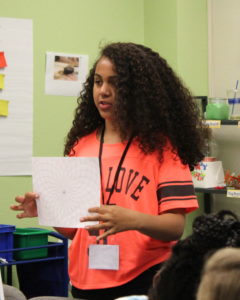 You can help youth celebrate all kinds of success, not just completed projects. Use opportunities such as group shout-outs, gallery walks, and one-on-one feedback to appreciate youth for their progress along the way.
You can help youth celebrate all kinds of success, not just completed projects. Use opportunities such as group shout-outs, gallery walks, and one-on-one feedback to appreciate youth for their progress along the way.
At the end of a project, give youth opportunities to share and talk about their work, whether through presentations to peers, at a science fair, or family event—it gives them invaluable opportunities to learn how to communicate with others and to act as STEM experts within their own communities. In our programs, we have Family Nights for girls to share their work, and they are always so proud to share what they’ve done!
We hope that these tips help to strengthen your youth Making experiences. Have some suggestions of your own? Please share them in the comments—we’d love to hear them!
